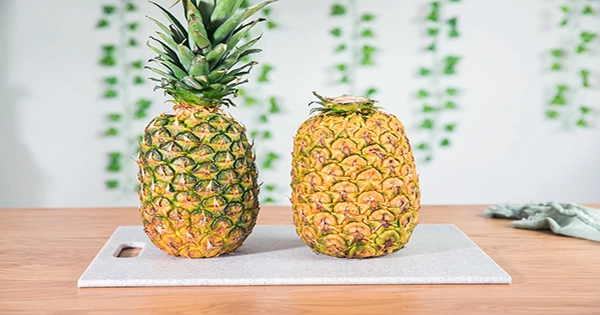“Your scientists were so consumed with whether or not they could, they didn’t pause to ponder whether they should,” stated Jeff Goldblum, referring to the choice to bring back gigantic, predatory dinosaurs, but the quote’s implications are broad. What’s new on the IFLScience radar? GMO pineapples with a ham-like tint. The pink pineapple, dubbed “Pinkglow” by its Del Monte developers, is a genetically modified organism (GMO) with flesh that is distinctly flesh-colored. The US Food and Drug Administration (FDA) gave it the light in 2016, but it won’t be available until 2020 — certainly a huge year for cursed things.
Pinkglow’s Ananas comosus “Rosé” cultivar belongs to the Bromeliaceae family and was generated by genetic engineering of the MD2 pineapple. It has a bright red tint with yellow specks and a distinct shell shape, all of which combine to produce healthy flesh-colored fruit. The flavor, on the other hand, is sweeter and less acidic than your ordinary pineapple, with overtones of “sugar pineapple aromatics,” according to Del Monte.
According to NBC News, the FDA declared in 2016 that “(Del Monte) provided documents to the agency to establish that the pink flesh pineapple is as safe and healthy as its traditional equivalents.” “(Del Monte’s) new pineapple has been genetically altered to generate lower quantities of enzymes that convert the pink pigment lycopene to the yellow pigment beta carotene, which are already present in normal pineapple. Lycopene is the pigment that gives tomatoes and watermelons their red color, and it is widely ingested and safe.”
Del Monte’s scientists created a pineapple strain with the genes that code for particular enzymes that render pineapples yellow switched down to make the flesh ham-pink. This means the fruit’s lycopene, a carotenoid pigment that is known to be a potent antioxidant, is preserved. All of this sounds fantastic, but not everyone has been won over by the Pinkglow aesthetic…
Del Monte calls it a “Jewel of the Jungle,” but is it a forbidden flesh fruit? You decide, but the GMO pink pineapple has several advantages beyond its lycopene content. Each Pinkglow pineapple (priced between $29.99 and $39.99) comes without a crown (the spiky piece on top) since they are chopped off at harvest and replanted in Costa Rica’s South-Central area, where they are farmed exclusively.
Del Monte claims that this procedure makes the fruit “fully sustainable” and may explain the high price. If spamapple isn’t your thing, try purple tomatoes instead. As UK business Norfolk Plant Sciences seeks approval for its Big Purple Tomato, a novel antioxidant-rich, GMO purple tomato might soon be available in shops near you. If mouse studies are any indication, the fruit (yes, tomatoes are really fruits) is packed with anthocyanins, which may have a good impact on longevity.














